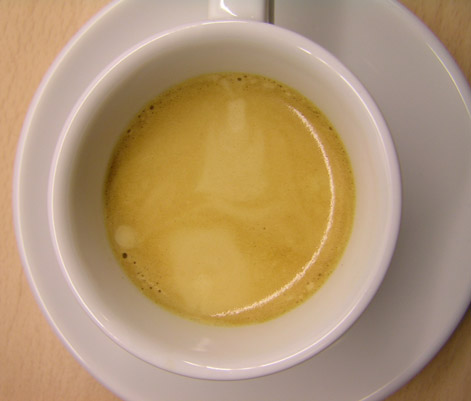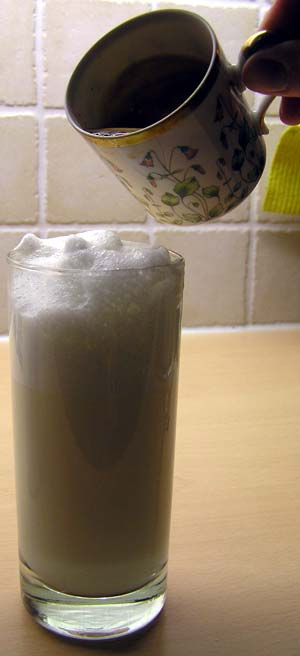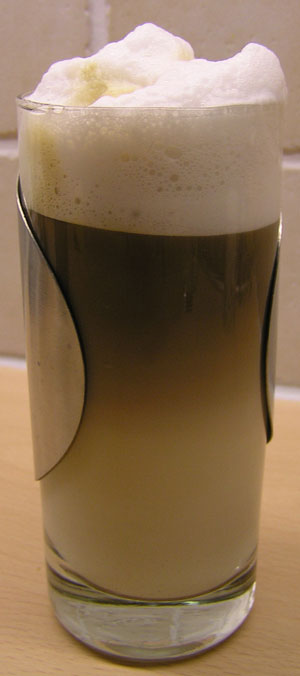Review of Siemens TK60001 Surpresso
S20
(In
swedish)
An automatic espresso machine.
Reviewed by Lars Tufvesson January 5, 2005. lars@bizzbook.com
Part
1, Part 2,
Part 3, Part
4
Usage
Look and feel
Siemens TK60001 Surpresso S20
has a black body (antracit) with details in silver color.
Siemens TK60001 was the cheapest
automatic espresso machine that was tested by the swedish
Råd & Rön magazine in December 2004,
with a recommended price of SEK 7300. The machine got
the best score in the test, together with the test most
expensive automatic espresso machine: Jura Impressa
F50. The recommended price for Jura Impressa F50 is
SEK 14000. To my knowledge, those two machines uses
the same inner parts, despite being different marks.
I think that Jura makes the inner parts for Siemens.
From the outside, the two machines looks completely
different.
Siemens TK60001 has a good look
and can proudly be placed on the kitchen bench, despite
giving a little plastic impression during a closer look,
for instance when opening the doors at the top of the
machine, and when adjusting the height of the espresso
pipe. Jura Impressa F50 gives a more elegant impression,
with fewer visible buttons and more metal.
Using Siemens TK60001 Surpresso
S20

Time to make the first espresso.
Turn on the power. Fill the water tank with water and
the grinder on the other side of the machine with coffee
beans. After about a minute, the machine is warmed up.
The coffee grinder was already
set to an appropriate degree of grinding. That was good,
because the degree of grinding is not changed that easy:
- The degree of grinding may
only be changed when the machine is grinding. That
is, you need to make an espresso to be able to change
the degree of grinding.
- The new degree of grinding
can not be noticed directly. The new degree of grinding
will be noticed first at cup number two or three.
Because of the above, I can not
fully agree with the sales brochure statements that:
- The grinder is very easy
to use.
- The newly brewn espresso
is made with newly ground beans.
The machine was set for a normal
esprsso:
- The function chooser was
set to ”espresso brewing”.
- The dial for amount of fluid
was set to "normal espresso size".
- The dial for amount of espresso/coffee
powder was set to "normal".
The first time the automatic espresso
machine is used, the pipes must be filled with water.
This happens the first time the cafe button is pressed.
The next time the cafe button
is pressed brews the first cup of espresso. When the
espresso machine has not been used for a long time,
you should not drink the first cup of espresso that
is produced. We made a new cup of espresso with an additional
press on the cafe button.
The espresso machine is not completely
silent. It emits several signs of life for every cup
of espresso that should be produced:
- You can hear how the beans
are grounded.
- You can hear how the pump
increases the pressure to be able to press the water
through the espresso/coffee powder.
- You can hear how the espresso
pours down in the cup.
- You can hear and see how
steam and preassure is released from the machine
afterwards.
How does the espresso taste? It
tastes good. Nothing to complain about. ...and there
is crema at the top too, exactly as it should be.

An espresso made by Siemens
TK60001 Surpresso S20.

The same espresso from
above.
Caffe latte and milk frothing
To test how good the machine was
at frothing milk, we decided to do our first caffe latte.
Note that there were no instructions about how to create
different espresso drinks delivered with the machine.
Fortunately, I had a book about espresso drinks in my
bookshelf.
According to the book, you need
0.2 liters of milk and a normal espresso to do a caffe
latte. We started with frothing and warming the milk,
because the milk will keep the temperature longer than
the espresso, since the amount of milk is greater
than the amount of espresso.

We moved the function selector
to "steam", and after a couple of seconds
we had steam from the steamer instead of water. We put
the steamer in the milk cup to have the steam go into
the milk about 10 millimeters below the surface. We
rotated the milk in the cup to have the milk heated
evenly. The volume of the milk increased as the number
of bubbles increased.
After a while the milk was warm
enough. (The bubbles was maybe too big. I will try to
create smaller bubbles next time. Remember, this was
the first time I used the machine.)
We turned off the steam, removed
the milk cup and cleaned the steamer by switching the
function selector to "hot water" for a short
while. This flushes hot water through the steamer. The
milk was poured into the pre-warmed serving cup. With
the help of a spoon you can get just as many milk bubbles
as you want.
Time to brew the espresso. Even
though the height of the pipes where the espresso comes
out can be adjusted, it was not possible to fit the
high caffe latte cup below the pipes. We had to let
the espresso pour down into a smaller cup, to be able
to get it into the the caffe latte cup later.
With water and beans in the machine,
with the function selector set for "espresso brewing",
with the dial for amount of fluid set to a normal espresso
and the dial for amount of espresso/coffee powder set
to normal, we only had to push the cafe button.
After a while, the espresso machine
produced the espresso.

We poured the espresso in the
caffe latte cup with the frothed and heated milk in,
to get our belonged caffe latte.
What about the result? We were
pleased. Already our first caffe latte made with our
new espresso machine got a "well done" verdict.

Our first
home-made latte.
- A nice visual impression
and a good taste.
- If we should complain on
anything it has to be on ourselves: We expected
more coffee taste in our latte. We will try to adjust
that for our next try. The bubbles can also be improved:
I will try to make them smaller the next time.
Cleaning and maintenance
The automatic espresso machine
cleans itself to a certain extent. There are some cleaning
and maintenance that you have to help with, though:
- After each time you have
frothed milk, you have to turn the function selector
to "hot water" to pour hot water through
the steamer for a short while, to get out any remaining
milk.
- Each day you have to dismantle
the steamer and clean the parts.
- Each day you should replace
the water in the water tank.
- Each day you should empty
and clean the coffe dregs tray and the tray for
waste water.
- When the machine after an
unknown number of espresso brewings indicates that
its time to run the cleaning programme, you have
to turn on the cleaning programme and add a cleaning
tablet that came with the machine when the machine
tells you so. I hope that it takes a long time before
the cleaning programme has to be run, because only
two cleaning tablets came with the machine. After
those, you have to order new ones from Siemens.
- When the machine after an
unknown number of espresso brewings (the number
partly depends on the water hardness on the place
where you live) indicates that it is time to run
the descaling programme, you have to start the descaling
programme and fill the water tank with half a liter
of water and descaling mixture that came with the
machine. Also here, you have to order more descaling
mixture from Siemens after a while.
Part four:
Comparison
and conclusion: How good is Siemens TK60001 Surpresso
S20 compared to other espresso machines?
Copyright © 2005 Lars Tufvesson.
All rights reserved.
|